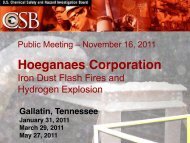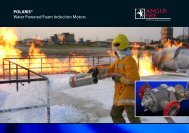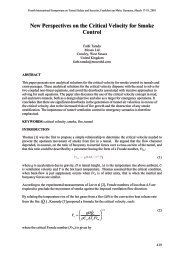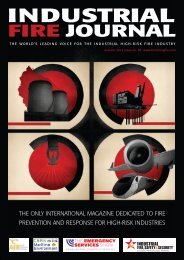Gas cooling.pdf - Industrial Fire Journal
Gas cooling.pdf - Industrial Fire Journal
Gas cooling.pdf - Industrial Fire Journal
Create successful ePaper yourself
Turn your PDF publications into a flip-book with our unique Google optimized e-Paper software.
GAS COOLING IN COMPARTMENTS<br />
<strong>Gas</strong> <strong>cooling</strong> to control the<br />
compartments<br />
In today’s built environment, a compartment fire<br />
develops quickly. Synthetic materials used in<br />
furnishings and interior finish have a much higher heat<br />
of combustion and heat release rate than the natural<br />
materials found in the built environment of the 1950s<br />
and 1960s. When a compartment fire develops,<br />
buoyant, hot smoke and entrained air form a layer at<br />
the ceiling and begin to fill the compartment.<br />
As the depth of the layer increases, the hot smoke and<br />
air begins to flow out through the opening into<br />
adjacent compartments, writes Chief Edward E Hartin,<br />
(MS, EFO, MI<strong>Fire</strong>E, CFO) of Central Whidbey Island <strong>Fire</strong><br />
& Rescue in the State of Washington, US, and owner of<br />
CFBT-US, LLC, an international fire behaviour training<br />
Figure 1: energy<br />
and mass transfer<br />
in a compartment<br />
fire.<br />
and related consulting service.<br />
The upper layer presents several hazards: 1) toxicity, 2)<br />
thermal energy, and 3) flammability. The hot upper layer<br />
transfers energy to fuel packages and compartment linings<br />
and begins to pyrolize other fuel packages into the gas phase fuel<br />
necessary for flaming combustion. The most unrecognised hazard<br />
is that smoke is fuel.<br />
When ventilation is limited, the oxygen concentration becomes<br />
insufficient for continued fire growth. In this ventilation controlled<br />
burning regime, combustion efficiency decreases and<br />
concentration of unburned flammable products in the smoke<br />
increases. Heat release rate is reduced, but the upper layer<br />
remains hot, resulting in ongoing pyrolysis. Failure of a window or<br />
creation of an opening as a firefighter enters provides additional<br />
oxygen and may result in rapid fire progression and depending on<br />
conditions may result in ventilation induced flashover or backdraft.<br />
How can these hazards be mitigated to provide a safer working<br />
environment for firefighters?<br />
Thermodynamics and firefighting<br />
Energy is transferred from materials of higher temperature to<br />
those of lower temperature. In a compartment fire, flames and<br />
the hot upper layer transfer energy to everything else in the<br />
compartment (including firefighters). Mass transfer not only<br />
involves movement of hot smoke out of the compartment, but<br />
also inward movement of air providing the oxygen necessary for<br />
continued combustion and fire growth.<br />
<strong>Fire</strong>fighting tactical operations influence this thermodynamic<br />
system in a number of ways, principally by applying and<br />
changing the ventilation profile. All fire control and ventilation<br />
tactics influence the compartment fire as a thermodynamic<br />
system.<br />
46 ❘ FIRE & RESCUE ❘ FOURTH QUARTER 2010 Read our e-magazine at www.hemmingfire.com
fire environment in<br />
appropriate under all circumstances! <strong>Fire</strong>fighters who work to<br />
become masters of their craft recognise that strategies, tactics,<br />
and techniques must fit the problems presented by the incident.<br />
<strong>Gas</strong> Cooling is the application of an appropriate amount of<br />
water fog into the upper layer to reduce the temperature of the<br />
gases.<br />
Vapourisation of water in the upper layer reduces the<br />
temperature of the hot gases, thermal load on the firefighters<br />
working below, and potential for ignition. While this sounds simple<br />
and fairly intuitive, this basic technique to control upper layer<br />
hazards is frequently misunderstood.<br />
Many firefighters in the United States believe that application of<br />
water into the upper layer in a fog or spray pattern will result in<br />
production of a large amount of steam which will fill the<br />
compartment and make conditions untenable. In many cases this<br />
is consistent with firefighters’ fireground experience. These<br />
firefighters are sceptical of <strong>cooling</strong> the upper layer with the<br />
application of water fog to improve conditions. The answer can be<br />
found in a statement made by Floyd Nelson (1989, “In principle,<br />
Ed Hartin, MS, EFO,<br />
MI<strong>Fire</strong>E, CFO<br />
serves as <strong>Fire</strong> Chief<br />
with Central<br />
Whidbey Island <strong>Fire</strong><br />
& Rescue in<br />
Washington (USA),<br />
and is the owner of<br />
CFBT-US, LLC.<br />
Ed was co-author<br />
of 3D <strong>Fire</strong>fighting:<br />
Techniques, Tips,<br />
and Tactics, and he<br />
delivers practical<br />
fire dynamics<br />
training<br />
internationally and<br />
across the US.<br />
Figure 2:<br />
short pulse.<br />
<strong>Fire</strong> control tactics<br />
It is essential to understand the interrelationship between<br />
ventilation strategies such as tactical ventilation (removal of<br />
smoke and introduction of air) and tactical anti-ventilation<br />
(confinement and exclusion of air) and fire control.<br />
It is fair to say that amongst fire services in the US offensive<br />
firefighting involves aggressive use of tactical ventilation and direct<br />
attack with high flow hoselines. In other parts of the world such as<br />
Europe and Australia, use of tactical ventilation is limited or highly<br />
controlled, and flow rates from hoselines are lower than those<br />
typically used in the US.<br />
While tactics vary, firefighters have often been taught not to put<br />
water on smoke. These cautions were based on the need to put<br />
water onto burning fuel for an effective direct attack and to limit<br />
production of steam which could add to the upper layer and<br />
worsen conditions for firefighters working at floor level. However,<br />
what happens when the fire is shielded from direct attack?<br />
<strong>Fire</strong>fighters must advance their hoseline to the seat of the fire,<br />
while working underneath the flammable upper layer. In a<br />
ventilation controlled regime, the air introduced when the<br />
firefighters made entry for fire attack can result in increased heat<br />
release rate and rapid fire progression. How can this hazard be<br />
mitigated?<br />
<strong>Gas</strong> <strong>cooling</strong> as a fire control technique<br />
First a qualifier, there are no universal solutions to control the<br />
hazards presented by a compartment fire. <strong>Fire</strong>fighters are often<br />
presented with ideas such as positive pressure ventilation (PPV),<br />
compressed air foam systems (CAFS), high pressure or ultra high<br />
pressure water fog, and gas <strong>cooling</strong>. and see these technologies<br />
or tactics as the solution. No one tactic or technique is<br />
Figure 3: heating<br />
and <strong>cooling</strong><br />
curves of smoke<br />
and water.<br />
Read our e-magazine at www.hemmingfire.com FOURTH QUARTER 2010 ❘ FIRE & RESCUE ❘ 47
GAS COOLING IN COMPARTMENTS<br />
Figure 4: gas<br />
versus surface<br />
<strong>cooling</strong>.<br />
Figure 5: volume<br />
changes during<br />
gas <strong>cooling</strong>.<br />
Note: adapted<br />
from Water and<br />
other<br />
extinguishing<br />
agents (p. 155),<br />
by Stefan<br />
Särdqvist,<br />
2002, Karlstad,<br />
Sweden (copyright<br />
Räddnings<br />
Verket).<br />
firefighting is very simple. All one needs to do is put the right<br />
amount of water in the right place and the fire is controlled.”<br />
As demonstrated by Superintendent Rama Krisana<br />
Subramaniam, Bomba dan Penelamat (<strong>Fire</strong> & Rescue Malaysia)<br />
[see figure 2] a short pulse can place a large number of small<br />
water droplets in the upper layer that develops during a<br />
compartment fire. When a pulse (brief application) of water fog is<br />
applied into a layer of hot smoke and gases with a temperature of<br />
500 o C (932 o F) what happens? As the small droplets of water<br />
pass through the hot gas layer, energy is transferred from the hot<br />
smoke and gases to the water. If done skillfully, the upper layer<br />
will not only be cooler and less likely to ignite, but it will contract<br />
(or at least stay the same volume) providing a safer working<br />
environment below. When water is turned to steam, it expands. At<br />
its boiling point, water vapourised into steam will expand 1700<br />
times. However, due to the tremendous amount of energy<br />
required to vapourise water (and resulting reduction in gas<br />
temperature), the final volume of the mixture of hot gases and<br />
steam is less than the original volume of hot gases within the<br />
compartment. Heating the water to 100 o C and production of<br />
steam transfers a tremendous amount of energy from the hot<br />
smoke and gases to the water, reducing the temperature of the<br />
hot gases. At constant pressure, the volume of a gas is directly<br />
proportional to its absolute temperature (if absolute temperature<br />
is reduced by 50%, volume will also be reduced 50%).<br />
The key<br />
The temperature of the gases is lowered much more than the<br />
temperature of the water is increased. As illustrated in Figure 3,<br />
the specific heat of smoke is approximately 1.0 kJ/kg (Särdqvist,<br />
2002; Yuen & Cheung, 1999) while the specific heat of water is<br />
4.2 kJ/kg and even more importantly the latent heat of<br />
vapourisation of water is 2,260 kJ/kg. What this means is that it<br />
requires over four times the energy to raise the temperature of a<br />
kilogram of water by 1 o C than it does to lower the temperature of<br />
smoke by the same amount. In addition, it requires 2,260 times<br />
the energy to turn 1kg of water to steam at 100 o C than it does to<br />
lower the temperature of 1kg of water by 1 o C.<br />
While water expands as it turns to steam, the hot gas layer<br />
contracts as its temperature drops. If the initial temperature of the<br />
hot gas layer is 500 o C (773 Kelvin) and its temperature is<br />
lowered to 100 o C (373 Kelvin) the absolute temperature is<br />
reduced by approximately half (773 K-373 K=400 K).<br />
Correspondingly the volume of the hot gases will also be reduced<br />
by half.<br />
<strong>Gas</strong> versus surface <strong>cooling</strong><br />
When vapourised in the upper layer, energy is transferred from<br />
the hot gases in the upper layer to; 1) raise the temperature of<br />
the water to its boiling point of 373.15 K (100 o C); 2) to change<br />
its state from liquid phase to gas phase; and 3) to raise the<br />
temperature of the steam until reaching equilibrium (hot gases<br />
and steam are at the same temperature).<br />
When water is vapourised on contact with a hot surface, it does<br />
not absorb significant energy while travelling through the hot<br />
gasses of the upper layer. The energy necessary to raise the<br />
temperature of the water to its boiling point and vapourise it is<br />
absorbed from the surface. Steam produced in this manner will<br />
also absorb energy from the hot gases of the upper layer (but<br />
increasing the temperature of the water in liquid form and<br />
vapourisation on contact with hot surfaces does not take<br />
significant energy from the hot gasses of the upper layer).<br />
As illustrated in Figure 5, the relative volume (expansion or<br />
contraction) of the upper layer during gas <strong>cooling</strong> is dependent<br />
on the percentage of water vapourising as water passes through<br />
the hot gases of the upper layer and the percentage of water<br />
vapourising on contact with hot surfaces such as compartment<br />
linings.<br />
Different parts of the elephant<br />
<strong>Fire</strong>fighters’ perspectives on the use of water fog for interior<br />
structural firefighting can be compared to the Indian fable of The<br />
six blind men and the elephant (Saxe, 1963). In this fable, the six<br />
men tried to determine what an elephant was. As none of the<br />
men could see, they used their sense of touch. However, each<br />
grasped a different part of the elephant. One touched the side<br />
and thought an elephant was like a wall, another the trunk and<br />
thought an elephant was like a snake, and so forth. What you<br />
believe may be limited by your point of observation and your<br />
understanding of what you are looking at.<br />
References<br />
Shaw, E. (1876). <strong>Fire</strong> protection. London: Charles and Edwin Layton.<br />
Nelson, F. (1991). Qualitative fire behavior. Ashland, MA: International Society of <strong>Fire</strong><br />
Service Instructors.<br />
Särdqvist, S. (2002). Water and other extinguishing agents. Karlstad, Sweden:<br />
Räddnings Verket.<br />
Yuen, K. & Cheung, T. (1999). Calculation of smoke filling time in a fire room - a<br />
simplified approach. <strong>Journal</strong> of Building Surveying, 1(1), p. 33-37<br />
Saxe, J. (1963). The blind men and the elephant. New York: McGraw-Hill<br />
48 ❘ FIRE & RESCUE ❘ FOURTH QUARTER 2010 Read our e-magazine at www.hemmingfire.com


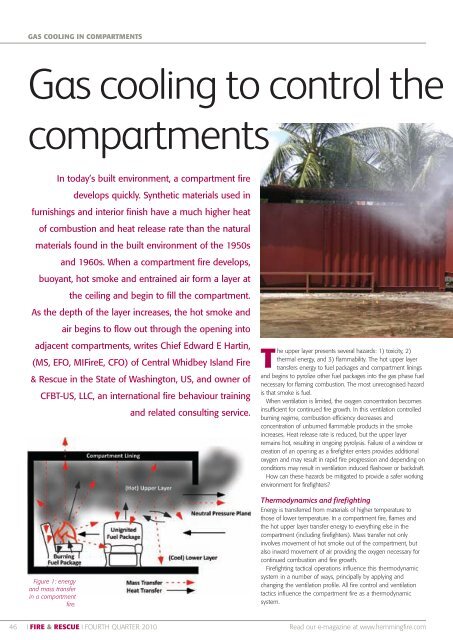
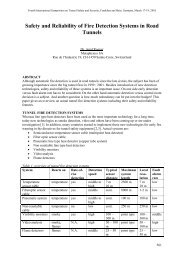
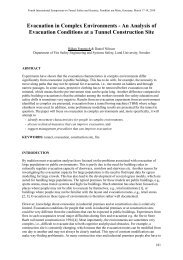

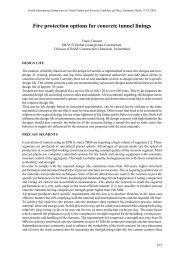
![30-37 TunnelsREV[1]rev.qxd - Industrial Fire Journal](https://img.yumpu.com/22237435/1/184x260/30-37-tunnelsrev1revqxd-industrial-fire-journal.jpg?quality=85)
